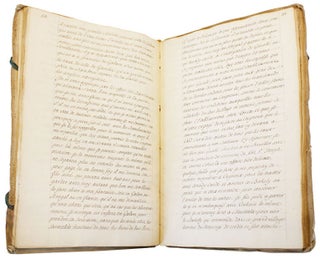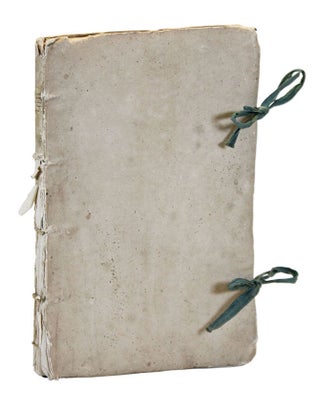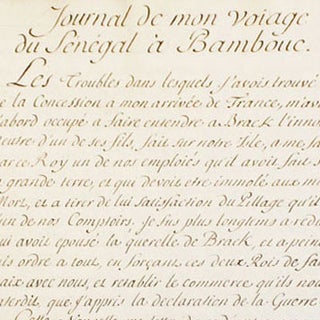Journal de Mon Voiage du Sénégal à Bambouc.
n.d. but 1745. Folio (38 cm.), limp paste-paper boards, green string ties, manuscript spine label. 135 pp. of fair copy manuscript. A substantial, visually impressive, and minutely detailed manuscript journal describing the activities of the Compagnie du Sénégal during the height of the Company's involvement in the slave trade. The Compagnie du Sénégal, the French chartered company governing the Saint-Louis and Gorée territories along the Western coast of Africa, was founded in 1696 and existed in three stages, from 1696 to 1697 under the government of Jean Bourguignon; from 1697 to 1702 under that of André Brüe; the last established in 1709, operating throughout the better part of the 18th-century. The Company relied heavily on the slave trade, flourishing through 1750, though by 1744, the year the present journal was written, financial difficulties were already apparent, the region having suffered a prolonged and debilitating drought. In that year the newly arrived governor of the Company (and almost certainly the author of this account) Pierre David responded to the drought by monopolizing access to what little grain had been harvested, causing a famine that only he could assuage, a tactic, having gone undetected by the locals, which left the people of Bambouk “at his feet” (Abdoulaye Bathily, “La Traite Atlantique des Esclaves et Ses Effets Économiques et Sociaux en Afrique,” in The Journal of African History, Vol. 27, no. 2, 1986, p. 288, our translation.) The present journal, though unsigned, has been positively attributed to Pierre David by André Delcourt, scholar and editor of the first published edition (1974), the attribution based on the year and contents coinciding with David’s tenure and activities as the governor of the Company's trading posts. The journal describes a 293-day voyage north from the port at Saint Joseph in modern-day Dakar, up to the coastal city of Saint Louis, and from Saint Louis, up the Senegal River to Podor, the northernmost town in Senegal. During his travels David combatted numerous bouts of debilitating illness while attempting to appease the various communities on his route, while simultaneously braving the dangers of his environs (“We found ourselves surrounded the entire night by lions, wolves, and tigers who howled without ceasing,” p. 108, our translation). Early on in his arrival David notes that the Company “complained that commerce at the trading post was ruined by the high mortality rate of the captives every year in Galam, and had intentions of closing the post if we could not find something more advantageous to do trade with the Africans” (p. 16). To offset these losses, David would establish a mining camp worked by “captives,” requesting of the Maraboux people “to only bring young people under the age of thirty years, that we would not trade in any other captives given the deaths we have had” (p. 26). True to his campaign, the author peppers his text with highly critical and dehumanizing descriptions of the various peoples he encounters, “The Saracolets, cowardly and weak as they are, never dare undertake anything themselves” (p. 66) while “all Africans are slow in their work” (p. 89). By the year’s end David had filled the trading vessel La Favorite with 450 captives (p. 113) and another ship bound for the mines with fifty captives more (p. 119). Despite several bouts of illness, David’s prose style remains keen if not overly florid, his descriptions chiefly centered on his political and economic machinations rather than his physical surroundings. Three extant manuscript copies of David’s journal are known to us, the earliest forming part of the manuscript collection of Charles-Etienne Coquebert de Montbret (1755–1831), in possession of the Municipal Library at Rouen, corrections to which appear to have been made in both David's and a later hand. This version would be discovered and published in 1974 by the Société Française d’Histoire d’Outre-Mer under the title, Journal d’un Voiage Fait en Bambouc en 1744. A second manuscript copy, written by an unversed scribe, with numerous misspellings of African names, can be found at the Bibliothèque de l’Assemblée Nationale de Paris (1974 ed., p. 21). Our copy, of unknown provenance, was acquired via auction in Great Britain in 2019. It differs only in a few minor particulars from the published version—for example, the sentence “[The Saracolets] pillage, steal, and murder with impunity” (1974 ed., p. 102) is present in the published version but not found in our copy, though whether as an oversight or by design is unclear. Though David’s text has been available to scholars since its publication in the 1970s, the manuscript offers a direct artifactual connection to a particularly violent period in French-African relations, a period when Galam saw more European slaving activity than any other African colony (Bathily, p. 271), when competing African maritime powers were constantly warring in order to sell captured prisoners to the trade (Bathily, p. 275). This copy of David's journal will raise additional questions for research: Was the manuscript destined for a contemporary publication, as the fair copy would suggest? If not, why and for whom were three copies disparately prepared? In whose hand—David’s, a secretary’s, or an anonymous scribe–were the manuscripts written? An important and intriguing document of the French slave trade in the early eighteenth century. CONDITION: Boards rather rubbed, bottom half of spine perished, hinges cracked but holding; Very Good, internally clean and fine. Offered in partnership with Lorne Bair Rare Books.
Item #5472
Sold





